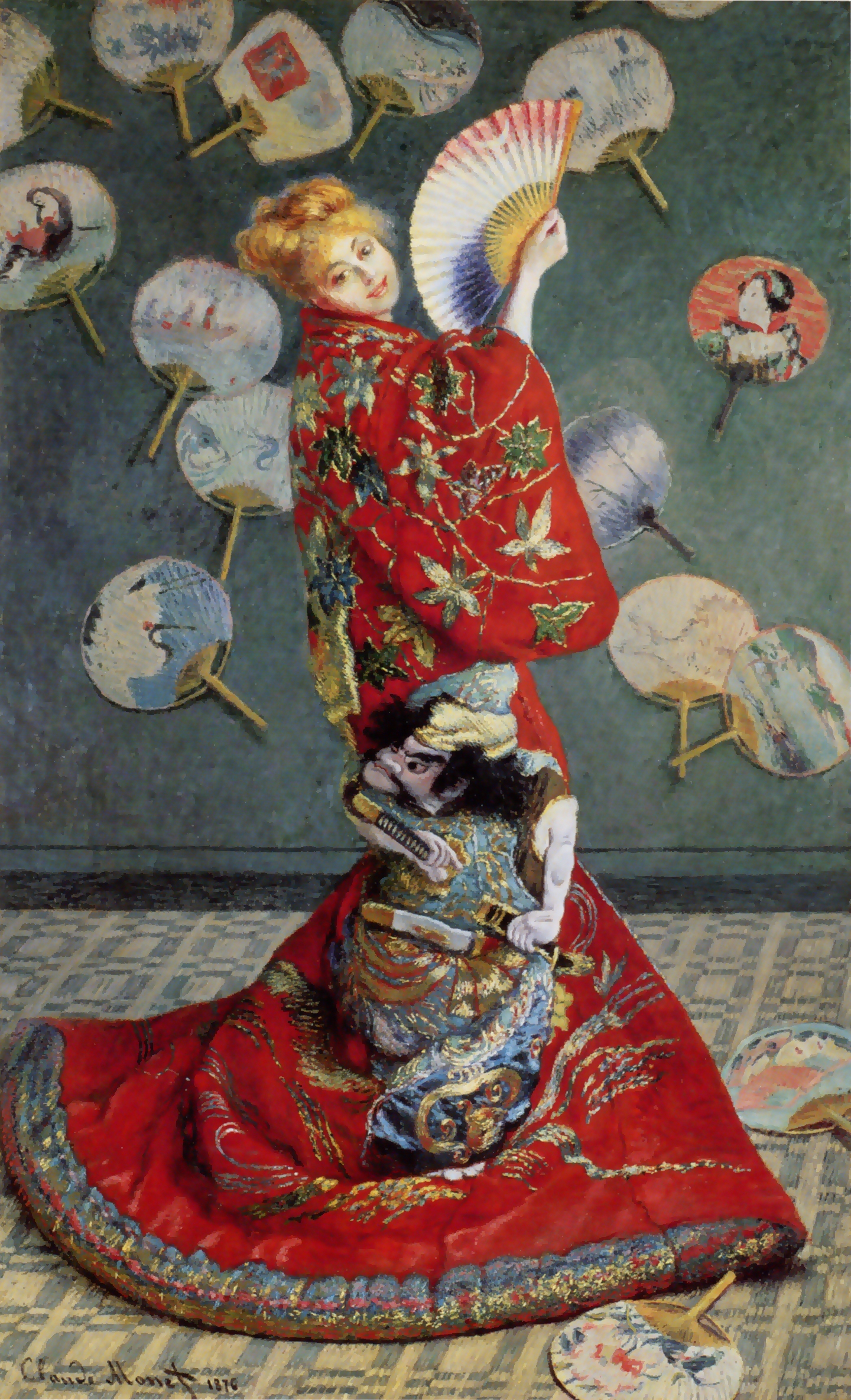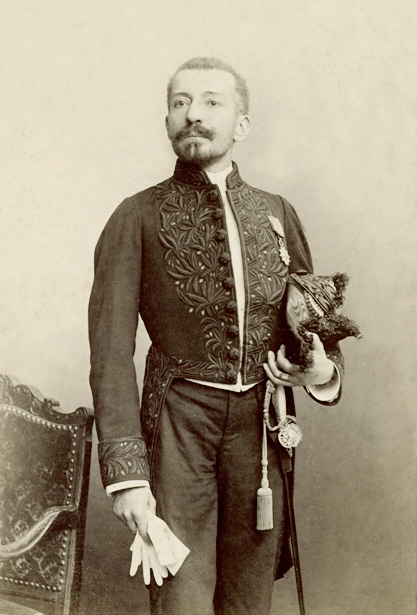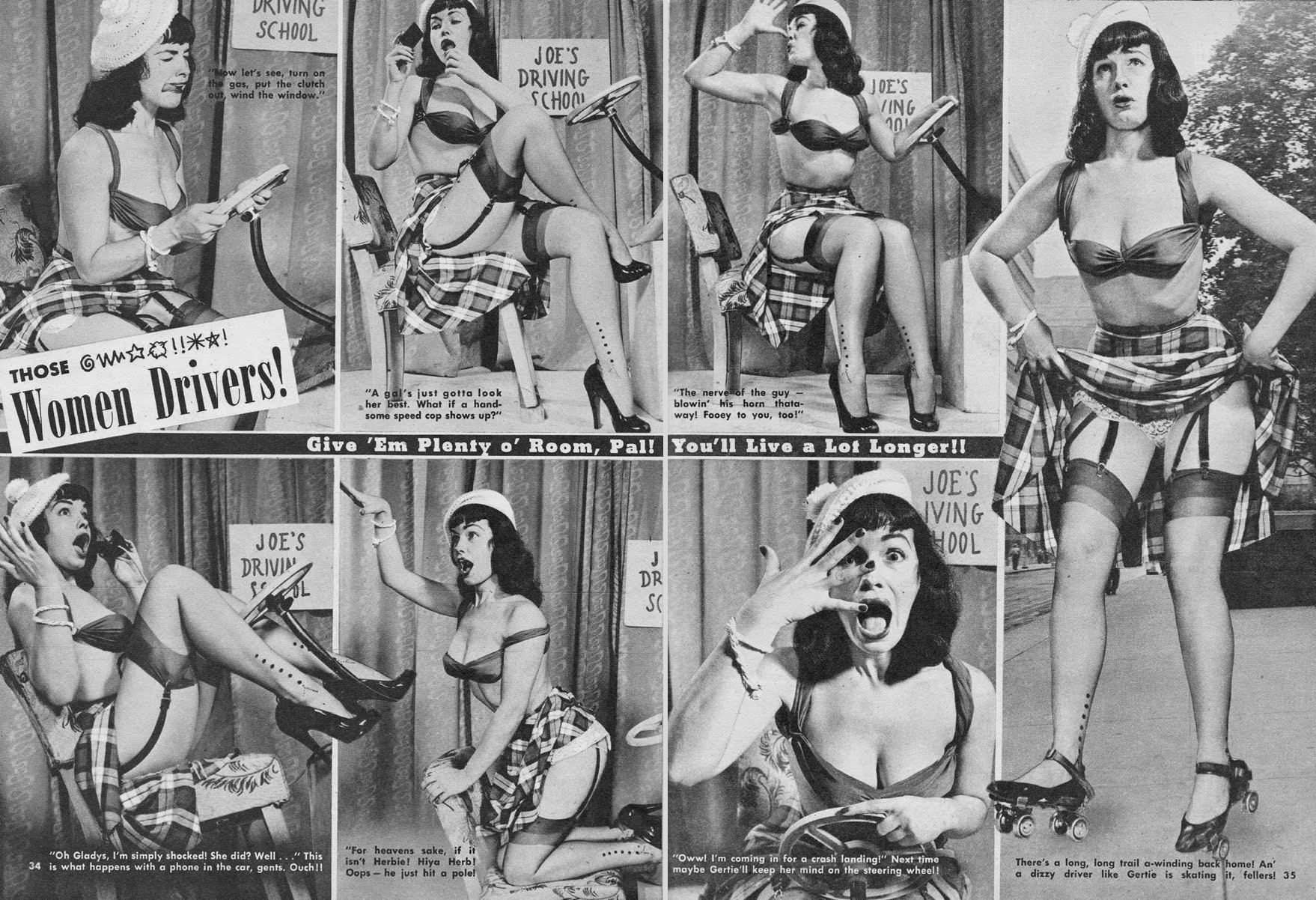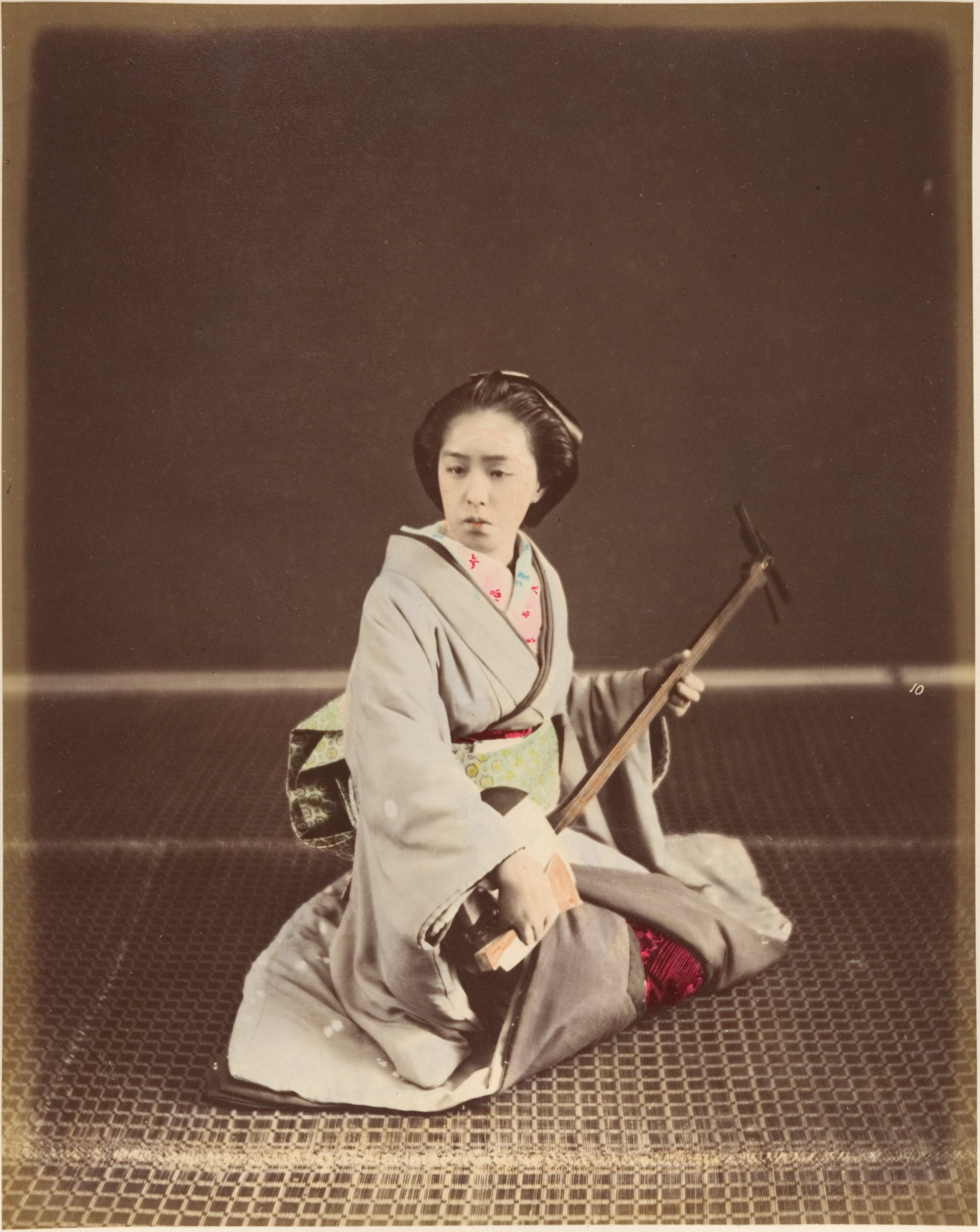Kimono as transnational Culture Essay Series : The birth of the Kimonope.
I have literally no respect whatsoever for this kretyn so I shall just discuss the damage he has and is still doing to Kimono culture outside Japan. Here I shall introduce the notion of the Kimonope, that is as a garment attached to the social construct of the 'Geisha' in North America. Kimonopes being Orientalized clothing, or 'negatively affiliated or exoticized ethnic dress' which lead to the perceived notion of the Kimono and Geiko as simultaneously both high and low culture to American culture makers, such as film, television, media, writers and some academics. An example of Kimonope are the tacky Halloween costumes you may find at the Dollar store.
John Luther Long (January 1, 1861 – October 31, 1927) was an American lawyer and writer best known for his short story "Madame Butterfly", which was based on the recollections of his sister, Jennie Correll, who had been to Japan with her husband—a Methodist missionary.
ジョン・ルーサー・ロング(John Luther Long、1861年1月1日 - 1927年10月31日)は、アメリカ合衆国ペンシルベニア州フィラデルフィア生まれの弁護士、小説家。
ロングは、姉のサラ・ジェーン・コレルが日本に滞在した際に聞いた話を基に、プッチーニ作のオペラ『蝶々夫人』(Madama Butterfly。1904年初演)の原作である短編小説『マダム・バタフライ』(Madame Butterfly)を書いたことで知られる。同小説は1898年にユタ大学の学生雑誌『センチュリー・マガジン』1月号に発表された。 [1]
The infamous Kimono Wednesdays. I began collecting and learning (that is the distinction between appropriation and appreciation afterall is said and done) in 2015. I only became aware of Kimono Wednesdays when it was mentioned by Rachel and Jun online I think in 2017. It was one of those incredibly surreal experiences you really only experience very rarely, like the fact Madam Efunroye Tinubu existed. The argument essentially became in the end 'Woke' students, who rightfully very angry about Anti-Asian-American sentiment and the subsequent weathering [2] they had been subject to their entire lives against the MFA and NHK, who were equally confused because this was a Japanese-American or Asian-American collaboration, about sharing their culture with Americans.
The results were as you would expect, a lot of misinformation being thrown around and people arguing with Brick walls at the end of the day. As whilst for the protestors, this was a battle for their heritage and representation in a historically prejudiced country (I'm thinking Vincent Chin, Fred Korematsu, the 2021 Atlanta shootings, comes to mind) appropriating their culture. But ownership is a tricky debate, and whilst I have no qualms with their sentiments, Japan has equally done questionable at the least in these very same arenas before, which smacks of the lack of care in the American education system like some cyclic Cerberus rearing its head to attack any common ground or sense in the whole maelstrom of surrealism that Kimono Wednesdays stood for.
As for the other side, I an obviously arguing my corner here, but really how do you explain the situation to a Japanese audience? It only comes across as 'the Americans' and all nuance becomes lost in translation when you see how Japanese audiences reacted to Kimono Wednesdays. After-all, a national Japanese broadcaster had proposed this idea, so to a domestic Japanese viewer, American society had rejected an extension of their national culture, the Kimono. Supplement that with American internments and the continued violence against Asian-Americans (who are not a monolith as apparently some people need reminding of that) and we have the great messy Kimono-Wednesdays-split special.
Common ground could have quite easily been met if the MFA had consulted people in the area, or even visitors on whether this was appropriate to them or not, and Japanese audiences could rightfully have been given a better grounding on the matter than just 'this protest happened? what are your thoughts about this?'. As usual, all of these ideas and things must be taken with a pinch of salt. Humans are rather strange like that, quick to celebrate, not so quick to learn from their mistakes, mostly their own. One of the reasons I write these essays, is to contextualize the Kimono (also not a monolith oddly enough, but a textile social construct and yes ALSO FASHION! Yegads!) internationally. If we are to accept the idea that Lolita for example is a Japanese fashion with Victorian and Rococo influences, we can quite easily see that Japanese fashion is transnational, and whilst there are people who believe culture is static and should not be allowed to be shared [3] between ethnic groups, a great many people find comfort in wearing Kimono and lolita as purely fashion, and in forming communities and identities and businesses (an important part of revitalising a 'dying' industry [4] I should think), and I shall argue in my next essay against the problems in falling into the surprisingly dangerous 'Kimono are only traditional garments' trap.
Instead though to refocus this rambling essay, I am taking a brief look into one part of the story of Kimono in North America and arguably popular global culture. The reason I quite despise John Luther Long is that he was the result of all that the protestors were worried about personified. I will gladly go on record and coin the neologism of 'Longingism' in his dirty, dirty honor. John Luther Long, or the defendant (he is guilty and yes I am the fashion police here) is guilty of the crime of clear (for once) mass cultural appropriation crimes on a grand scale. In the culture wars, it is arguably his work which western society has relied on in 'mainstream' culture to contextualize Kimono. Which is sort of like whenever Americans whip out the Downton Abbey dresses for me, and declare this is my whole culture, and the rest is useless. Or reductionism and erasure.
I am talking of course, of the inclusion of the Kimono as 'ethnic dress' in the defendants Madame Butterfly, as the original 'timid, subservient, filial piety' Asian woman stereotype found in Pierre Loti's 1887 Madame Chrysanthemum was in French[6], so of course we needed an English version! (Sarcasm, that is sarcasm, see Satire, I'm sure the Crawleys have seen a play or two; no I have not tortured myself by watching Downton Abbey either). Whilst the operas are arguably more influential in trickle-down-culture-proliferation, the operas had to have a source to begin with, and fairyland Japan is a racialists wet dream of course, so we then turn to the illustrated edition of a white cishetereonormative allosexual male North American writer on Eastern topics. Of which I can only imagine the 'Butterfly' to be an adapation of the equally white cishetereonormative allosexual male North American artist on Eastern topics (yes the whitewashed Princess from the land of Porcelain [5] has Orientalist overtones) Mr.Whistler who took on the form from Japanese Ukiyo-e as a signature motif in his own work.
Madame Butterfly; Purple eyes; A gentleman of Japan and a lady; Kito; Glory [7] was the original 1898 short story format which inspired Puccini's ever more famous Madam Butterfly opera. Butterfly was the kind of **** you should find in a Museum display case extolling the virtues of equality but alas no. The 'plot' goes along the usual lines, Pinkerton; the dashing American solider; who goes to Japan to marry a 15 year old girl. Finding the distraught 'Geisha' (not the kind I know) Cho-Cho-san (did he write it on the train on the way back home perhaps?), he saves poor Cho-Cho-san by marrying her. Then as any self-respecting normal person does, isolates her from everyone around her, forces his ideals of 'western fashion' down her throat, and becoming bored (did I mention this is the only real reason he marries her in the first place as in Pinkertons mind, Cho-Cho is below him; or the subservient Asian women) leaves her, promising to return albeit with no intention to, with no means to support herself and their new household (Cho-Cho also gives birth to his child) and goes back to the good ol' USA. Instead of the classic Loti ending though, Cho-cho who is the good ol' subserviant stereotype and subserviant Asian woman trope, does in fact wait for him in a stockholm syndrome fashion, denies marrying again and eventually leaves this world for the next one out the horror of finding he is not going to return.
Truly the overt racism and racialist attitudes can be found in the line; 'You thing mebby he keer yaet for me? No! He got come an' fight. An' I lig jus' see him-if he come, of course. Me? I don' keer liddle bit!' found on page 209. To read the full book copy reference 7 into any web browser.
The book is 224 pages long. The quote mentioned above constitutes around 89% of this book. 200 pages of subservient Asian woman stereotyping. It is from this which we derive the North American (Europe of course has Loti) stereotype of the 'Geisha'. The 'Geisha' being a sort of catchall term for what American men such as Arthur Golden have used to make false or misleading notions into narratives, as Mineko Iwasaki has said herself [8], has amounted to a perception of Geiko as 'highly cultured prostitutes'. Seeing as there is not the social and financial incentive for these men to denounce this, this leaves Japanese-Americans or Japanese nationals in the firing line for this despicable reductionist narrative which is what the 'woke protestors' felt they were up against at the MFA, and understandably so on a surface level. It is through this narrative, that popular American culture, driven by these same financially successful men, have introduced Kimono into the 'mainstream' media culture, proudly conflating the 'Geisha' as Japanese, rather than American patriarchal power fantasy, and 'Kimono' as glorified bathing robe since 1924.[9][10] And also in challenging the mythological monolith and cultural hegemony; what it means to be 'authetically'; both of Asian-Americanness and Japaneseness.[11]
It is telling therefore that the original source material for Longism is the illustrations of Madame Butterfly the novel. 2 illustrations of the kimono are found throughout the work and depict the kimono. I shall term them A and B, as A is more prominent, but B more accurate, and the argument I imagine the 'authenticity' or static culture crowd would use as evidence for their case in fashion court. I charge the defendant to be guilty, because in his work, exhibit A is a state of Kimono most prominent, most easy to find, and is not accurate to contemporary or everyday life in the the late 19th century to be period accurate, and which became the most proliferated image after the fact.
B is found on page 159, and is commendable if we remove it from the books ugliness in depicting a woman wearing a Kimono, playing what looks like a shamisen which are typical Geiko social constructs.
How are these things part and parcel of Longingism you may ask? Well cast your best guesses to the Paparazzos, because Japan is on the act too. Long obviously was aware of Japanese culture, but he undertook it as one giant blob he called 'Japan'. This was as Wilde has explained, not Japan but *J*a*p*a*n*, the image created in Longs mind of Japan. And Japan certainly would have helped in the pushing of the 'Good Wife, Wise Mother' doctrine with regards to how a 'true Japanese' woman should act, given it was considered a woman's patriotic duty to be demure and second to her husband.[12] Long has obviously taken this in from his sister's experiences in Japan in some juncture and thus 'Japanese womanhood' as defined by the patriarchal system created by Nakamura Masanao shapes Japanese women as what the British tabloid press expect of Kate Middleton, of pure, childbearing machines who walk behind rather than beside their husbands. Add a sprinkle of whatever it is that caused likeminded buffoonery such as White Man's Burden (1899) [13] and we have the submissive, devoted shell of a being that is Cho-Cho-san. Depicted in A with her baby or doll (porcelain princesses and dolls are another favorite of Longs original intended audience), the kimono becomes associated as a garment worn by infantilised, submissive, child-heavy, no-backtalk with the odd 'exotic' cultural marker such as Samurai, Bushido, Mt.Fuji and Ikebana to the picture and we have established the Kimono as a cultural marker in line with the subservient 'Asian woman' trope.
I mention Ikebana and Fusiyama (Fuji) as these at the time were well established Japanese cultural markers of Japaneseness to foreigners and Japanese nationals, and still are today. However we must remember the Othering impact which Longingness has in turning Japanese women in the 'Geisha'. Ikebana has a cultural significance to Japanese purity and vigilance to detail, understatement rather than vulgarity or sex as found in *J*a*p*a*n*. As part of the notion of being Iki (粋)[14] one is refined and demure, typically holding conservative rather than liberal values as Western audiences would define them. An 粋着物 therefore is often those grey, old lady kimonos, or their western equivalent being the 'cool-conservative-grandma'. The notion of Iki and Yamato Nadeshiko are heavily intertwined to conservative purity values of what 'Japaneseness' was and still is a heavy part of the visual makeup of ethnocentric Japan.[15] Other visuals and discriminatory policies are available and will be explored later on in another post.
It is this Yamato Nadeshiko and Confucian purity and filial piety notion, which is a principle component of how Long presents Cho-Cho and *J*a*p*a*n*.[16][17] This is a reflection of the monolithic-ness of ethnocentric Japan, in the mirror of American ethnocentrism which creates in turn as Wikipedia notes, the buffoonery of a thought process which allows one group of people to think the Holocaust was a good thing and intern millions of people based on a perceived visual or 'racial' slight, casting them as the Other, or Othering them.[15] So in other words, when Japanese people typecast half their population as 'pure' and 'honourable', westerners like Longs sister, took home these notions with them to the USofA and feed them to the same people like Long, who created new images of *J*a*p*a*n*e*s*e* womanhood, and birthed the 'Geisha' trope in the United States. In this climate, culture became weaponised for national purposes, in America this used the Kimono as a cultural marker of the sexually available *J*a*p*a*n*e*s*e woman, or a Geisha.
In other words, the kimono, a thing to wear, was turned into Cho-cho-san, an object used to the ends of its new creators. The Kimono suddenly became an American garment, the *K*i*m*o*n*o*p*e* (as I shall call it) which was acceptable to put onto the stage, into the hands of GI's in the 1950's and feeding the problematic 'dying industry' narrative we have around Kimono wearing today we find in films like Memoirs of a Geisha.[18] Kimonope certainly an American invention, should not be conflated with Kimono by Asian-Americans, and as a garment Kimono are also inherently, as with all objects, dynamic and use multiple sources of influence and inspiration. Particularly within the broad scope, fashion and history of Kimono as a garment, and narrowing who, why, how and when Kimono is considered appropriate to be worn by, when the answer from Japanese audience is generally anyone can be taken as cultural appropriation rather than appreciation in itself.[19]
Exhibit A though is a fine specimen of Longingism Kimonope your honor, and certainly deserves to be examined as such, whilst giving the due study and diligence Kimono deserves in transnational contexts. We do not I hope therefore need to have the debate as to whether the Top and Bottom are global garment constructs as is the Kimono, and that defendant in their creation of the Kimonope, and popularisation of the Geisha, that you will find the defendant guilt as charged. I the fashion police, rest my damn case.
Concluding
In context therefore, we see that in the transnational context, Kimono has also become a cultural marker denoting similar and disparate value systems globally. The Kimono Bergere and other actresses (Cho-Cho) worn onstage in the Butterfly plays of 1900-1914 were used to denote that its wearer was a 'Japanese' woman, which many audience members may have filled in as being worn by the 'Geisha' without the correct background knowledge of the national, social and textile cultures which gave these attributed values such as purity in Japan and sexual attraction and submissiveness by Western audiences. John Luther Long contributed to the creation of visual Kimono culture by creating the Kimonope, or the sexy kimono, or tacky Halloween kimonos and it will haunt us forevermore.
The next essay will focus on the problems with the decline of the Kimono-wearing in Japan and how this 'dying industry' narrative damages and Orientalizes the Kimono as an institution.
Reference List
[1] https://en.wikipedia.org/wiki/John_Luther_Long
[2] https://www.medicalnewstoday.com/articles/weathering-what-are-the-health-effects-of-stress-and-discrimination
[3] https://www.youtube.com/watch?v=jZ4bNh0TnMI
[4] https://www.youtube.com/watch?v=TTn7bosRxWE
[5] https://en.wikipedia.org/wiki/The_Princess_from_the_Land_of_Porcelain
[6] https://en.wikipedia.org/wiki/Madame_Chrysanth%C3%A8me_(novel)
[7] https://archive.org/details/madamebutterflyp00longiala/page/n8/mode/1up
[8] https://www.nytimes.com/2001/06/19/books/arts-abroad-a-geisha-a-successful-novel-and-a-lawsuit.html?pagewanted=all
[9] https://eu.cincinnati.com/story/entertainment/arts/2014/07/20/beloved-butterfly-first-opera/12833371/
[10] https://www.metopera.org/discover/synopses/madama-butterfly/
[11] https://medium.com/@OPERAAmerica/the-butterfly-conundrum-46a78f58d8a1
[12] https://en.wikipedia.org/wiki/Good_Wife,_Wise_Mother
[13] https://en.wikipedia.org/wiki/The_White_Man%27s_Burden
[14] https://en.wikipedia.org/wiki/Iki_(aesthetics)
[15] https://en.wikipedia.org/wiki/Ethnocentrism
[16] https://en.wikipedia.org/wiki/Yamato_nadeshiko
[17] https://en.wikipedia.org/wiki/Filial_piety
[18] http://www.costumersguide.com/cr_geisha.shtml
[19] https://www.youtube.com/watch?v=Lv96Rq6A7k8
Social links:
https://www.etsy.com/uk/shop/KaguyasChest?ref=seller-platform-mcnav or https://www.instagram.com/kaguyaschest/ or https://www.youtube.com/channel/UC5APstTPbC9IExwar3ViTZw, or https://www.pinterest.co.uk/LuckyMangaka/hrh-kit-of-the-suke/

















No comments:
Post a Comment